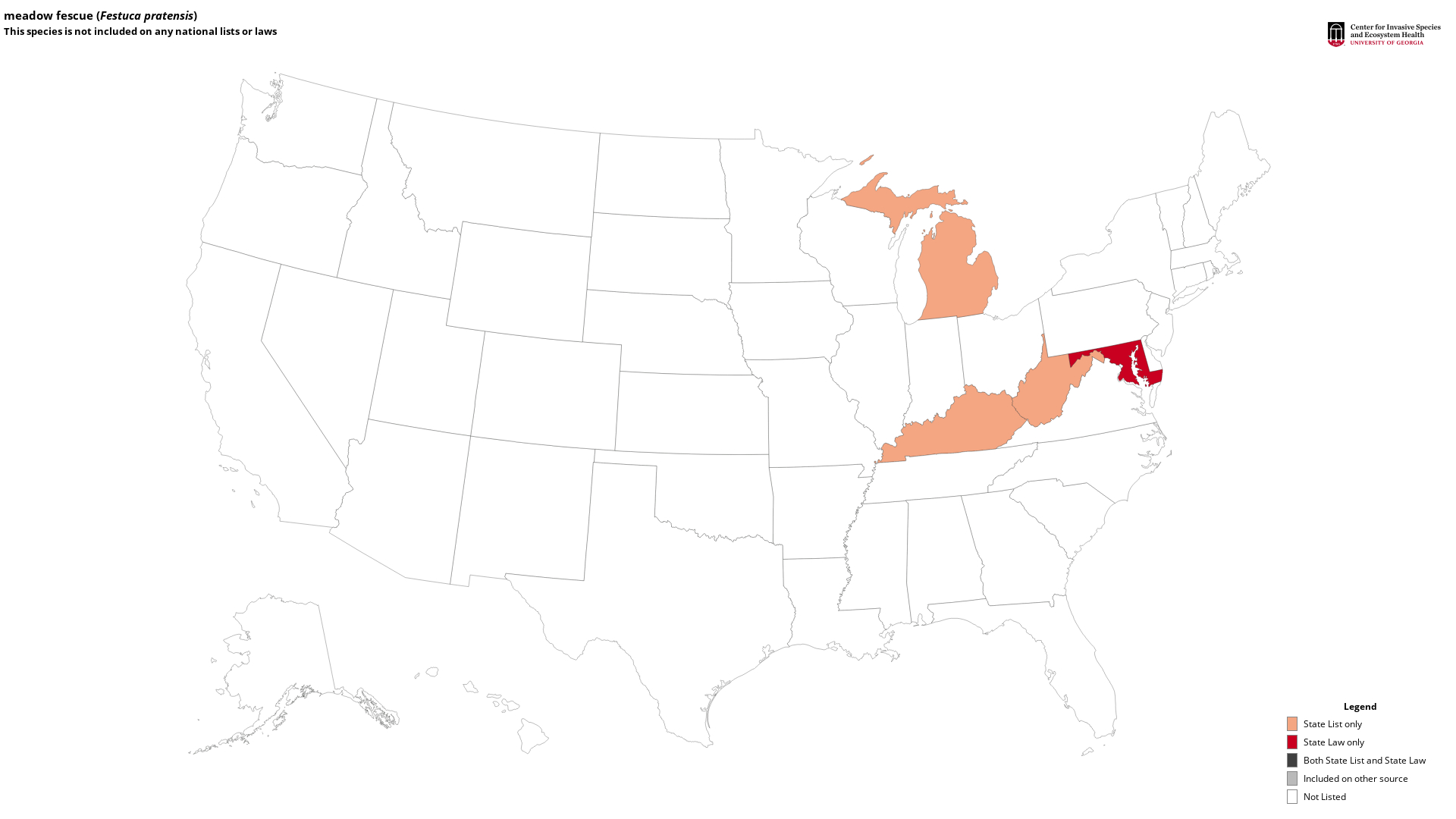meadow fescue
(Festuca pratensis)
This species is Introduced in the United States
Origin
Native to Europe.
Appearance
Festuca pratensis is a perennial grass approximately 1 ½ -4′ tall. Meadow fescue is native to Eurasia.
Foliage
Leaf blades are flat, 12″ in length and 8 mm wide on stems between 50 and 100 cm in height.
Flowers
Meadow fescue consists of multiple lemmas that have a perfect floret with 3 stamens, 2 stigmata, and an ovary. The blooming period occurs from mid- to late summer and lasts approximately 1-2 weeks. Florets are cross-pollinated by wind.
Fruit
Each floret is placed by a single grain approximately 3-3 ½ mm in length, light tan in color, and ellipsoid in shape.
Ecological Threat
F. pratensis habitat includes remnants of prairies, woodland borders, vacant lots, degraded meadows, pastures, and fields, as well as sides of railroads and roadsides. Preferring full to partial sunlight in loam or clay-loam soils, meadow fescue was introduced as a source of pasturage and hay for farm animals in the United States.
https://www.illinoiswildflowers.info/grasses/plants/mdw_fescue.htm
Native to Europe.
Appearance
Festuca pratensis is a perennial grass approximately 1 ½ -4′ tall. Meadow fescue is native to Eurasia.
Foliage
Leaf blades are flat, 12″ in length and 8 mm wide on stems between 50 and 100 cm in height.
Flowers
Meadow fescue consists of multiple lemmas that have a perfect floret with 3 stamens, 2 stigmata, and an ovary. The blooming period occurs from mid- to late summer and lasts approximately 1-2 weeks. Florets are cross-pollinated by wind.
Fruit
Each floret is placed by a single grain approximately 3-3 ½ mm in length, light tan in color, and ellipsoid in shape.
Ecological Threat
F. pratensis habitat includes remnants of prairies, woodland borders, vacant lots, degraded meadows, pastures, and fields, as well as sides of railroads and roadsides. Preferring full to partial sunlight in loam or clay-loam soils, meadow fescue was introduced as a source of pasturage and hay for farm animals in the United States.
https://www.illinoiswildflowers.info/grasses/plants/mdw_fescue.htm
Maps
EDDMapS Distribution - This map is incomplete and is based only on current site and county level reports made by experts, herbaria, and literature. For more information, visit www.eddmaps.org
State Lists - This map identifies those states that have this species on their invasive species list or law.
Invasive Listing Sources
- City of Ann Arbor Michigan Parks and Recreation
- Invasive Plant Species of West Virginia
- Jil M. Swearingen, Survey of invasive plants occurring on National Park Service lands, 2000-2007
- John Randall, The Nature Conservancy, Survey of TNC Preserves, 1995.
- Kentucky Exotic Pest Plant Council - Significant Threat
- Maryland Code and Regulations Noxious Weed & Seed Law
- National Park Service, Mid-Atlantic Exotic Plant Management Team Invasive Plant List
- Nonnative Invasive Species in Southern Forest and Grassland Ecosystems
- WeedUS - Database of Plants Invading Natural Areas in the United States
- West Virginia Invasive Species Strategic Plan and Volunteer Guidelines 2014
- West Virginia Native Plant Society, Flora West Virginia Project, and West Virginia Curatorial Database System, September 3, 1999
Taxonomic Rank
| Domain: Eukarya |
| Kingdom: Plantae |
| Phylum: Magnoliophyta |
| Class: Magnoliopsida |
| Superorder: Lilianae |
| Order: Poales |
| Family: Poaceae |
| Genus: Festuca |
| Festuca pratensis |
Synonyms and Other Names
Other Common Names:
meadow fescue
Related Scientific Names:
Lolium pratense (Huds.) S.J. Darbyshire (Synonym)
Schedonorus pratensis (Huds.) Beauv. (Synonym)


